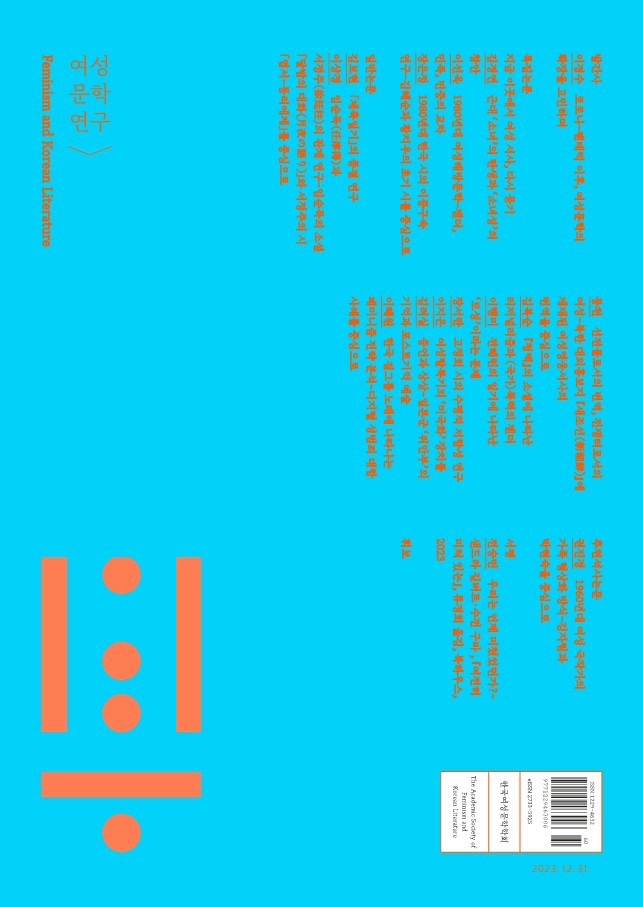- KOREAN
- P-ISSN1229-4632
- E-ISSN2733-5925
- KCI
 ISSN : 1229-4632
ISSN : 1229-4632
Sexuality over the Boundaries and Extension of Modern Knowledge Power : A Study on the Discourse of Sexuality in the Korean Yellow Journal of the 1960s
Abstract
This article examines how the Korean Yellow Journal Myeong-lang(Gaiety) commodified sexuality and analyzes the discourse structure of sexuality of the Journal in the 1960s. In the 1960s, focused on sexuality outside family system, Myeong-nang pursued profits by seeking after a sexuality commercialization strategy that prompted the public's curiosity about sex using such kind of articles including an affair, a prostitution, a premarital and extramarital affairs. Myeong-lang printed actively the Western trend of sexuality where signs of sexual openness regarded as evident. With deliberate misuse of Western examples such as the Kinsey report, together with deliberate misappropriation of the gender openness as a universal fact, Myeong-lang defined contemporary Korean society as a sex liberation one based on the Western model. Sexual articles in the journal had taken the form of discourse of education that male intellectuals uttered to female readers, and made sexuality of woman a subject of discipline. Articles on sex science in the journal defined male sex as a possessive and aggressive “sad instinct,” and the journal justified the contradictory sexual desire of male who desired both a virginity and a preoccupation relation with a woman. Myeong-lang extended the control of knowledge power outside of the family system with hierarchizing the sex difference by educating the sex of the woman as the sex that should conform to the desire of the male. In such a discourse structure, the magazine's sexual science accelerated the pornographic desire to see the reality of sexuality by searching for sexuality to the stage of contraction and expansion of muscle. By this way, the sexuality of a woman was typified and objectified in the overflow of sexual discourse. The women’s memoirs of the magazine, illuminating a woman’s life of the prostitution zone in the society, repeated similar stories in a homogeneous circuit binding women's desires with corruptions. These handwritings, which had a clear trail of editorship, proceeded in a careful arrangement of gaze to encourage men's curiosity and desire. The rapidly developing narrative had functioned as a sexual surrogate by expanding the scene of extramarital affairs. In the homogeneous narrative structure that satisfied the desire of pleasure while offsetting the guilt of men, the women's memoirs of Myeong-lang served to extend the control range of the knowledge power that constituted modernity. As the overflow of sexuality accelerated, the true experience and desire of women had to be deeply covered and silenced.
- keywords
- 『명랑』, 대중, 섹슈얼리티, 성 담론, 옐로 저널, 여성성, 체험 수기, 성 과학, 1960년대, 근대성, 성 역할, 페미니즘., Sexuality, Sexual discourse, Yellow journalism, Femininity, Memoirs, Sex science, The 1960s, Modernity, Sexual role, Feminism.
Reference
『명랑』 1960-1973년 현전본(국립중앙도서관)
권보드래, 『연애의 시대』, 현실문화연구, 2002.
여성문학연구회, 『여원연구: 여성, 교양, 매체』, 국학자료원, 2008.
최인호, 「작가의 말」, 『별들의 고향』, 샘터, 1994.
린 헌트, 조한욱 역, 『포르노그라피의 발명』, 책세상, 1996.
김석, 「여성의 몸과 불가능한 주이상스」, 몸문화연구소 편, 『포르노 이슈』,그린비, 2013, 154-183쪽.
김연숙, 「대중잡지 『명랑』을 통해 본 전후 개인관계의 서사 - 1950년대 후반‘독자사교란' 기획을 중심으로」, 『대중서사연구』 22, 대중서사학회, 2016, 39-69쪽.
김예림, 「1960년대 중후반 개발 내셔널리즘과 중산층 가정 판타지의 문화정치학」, 『현대문학의 연구』 32, 한국문학연구학회, 2007, 339-375쪽.
김은실, 「한국 근대화 프로젝트의 문화 논리와 가부장성」, 『당대비평』 8호, 생각의나무, 1999, 79-100쪽.
김종갑, 「실재를 향한 열정으로서의 포르노」, 몸문화연구소 편, 『포르노이슈』, 그린비, 2013, 96-120쪽.
김지영, 「가부장적 개발 내셔널리즘과 낭만적 위선의 균열」, 『여성문학연구』, 여성문학학회, 2017, 57-104쪽.
김지영, 「1950년대 잡지 『명랑』의 “성”과 “연애” 표상: 기사,화보,유머란(1956∼1959)을 중심으로」, 『개념과 소통』, 한림대학교 한림과학원, 2012, 173-206쪽.
김지영, 「'명랑성'의 시대적 변이와 문화정치학: 통속오락잡지『명랑』의 명랑소설(1956년-1973년)을 중심으로」,『어문논집』78, 민족어문학회, 2016, 217-268쪽.
김현주, 「1950년대 오락잡지에 나타난 대중소설의 판타지와 문화정치학: 『명랑』의 성애소설을 중심으로」, 『대중서사연구』, 대중서사학회, 2013, 83-116쪽.
송은영, 「1960-70년대 한국의 대중사회화와 대중문화의 정치적 의미」, 『상허학보』 32호, 상허학회, 2011, 187-226쪽.
유지나, 「여성 몸의 장르: 근대화의 상처 – 1970년대 후반에서 1980년대」, 유지나, 조흡 외, 『한국영화 섹슈얼리티를 만나다』, 생각의 나무, 2004.
이나영, 「포르노그래피, 억압과 해방의 이분법을 넘어」, 김종갑 외, 『포르노이슈』, 몸문화연구소 엮음, 그린비, 2013.
이우영. 「포르노그라피의 사회적 의미」. 『현상과 인식』 22(1·2), 한국인문사회과학회, 1998, 25-41쪽.
이주라, 「음란 소녀 탄생기 – 1960년대 대중 잡지 『명랑』과 하이틴 소설」, 『대중서사연구』, 대중서사학회, 2018, 439-477쪽.
임유경, 「지식인과 잡지 문화」, 김성보 외 편, 『한국현대생활문화사: 1960년대』, 창비, 2016, 83-110쪽.
임종수·박세현, 「『선데이서울』에 나타난 여성, 섹슈얼리티 그리고 1970년대」, 『한국문학연구』 44집, 동국대학교 한국문학연구소, 2013, 91-136쪽.
장미경, 「1960-70년대 가정주부(아내)의 형성과 젠더정치: 『여원』, 『주부생활』 잡지 담론을 중심으로」, 『사회과학연구』 15, 서강대학교 사회과학연구소, 2007, 142-181쪽.
주유신, 「포르노그래피와 여성의 성적 주체성 – 페미니스트 포르노 논쟁과 두 편의 텍스트를 중심으로」, 『영화연구』 26호, 한국영화학회, 2005, 397-424쪽.
최경희, 「1960년대 여성지를 통해 본 ‘교양의 레짐’ 연구: 『가정생활』, 『여상』,『여원』에 나타난 전통, 국민, 감정의 동원체제를 중심으로」, 『우리문학연구』 48, 우리문학회, 2015, 89-112쪽.
최경희, 「1960-1970년대 여성지를 통해 본 근대화의 젠더 양상 연구: 『여원』, 『여상』, 『주부생활』에 나타난 근대화의 혼종적 성격을 중심으로」, 『한국문학이론과비평』, 한국문학이론과비평학회, 2016, 313-331쪽.
최애순, 「1950년대 활자매체 『명랑』 ‘스토리'의 공유성과 명랑공동체」, 『한국문학이론과 비평』 59, 한국문학이론과비평학회, 2013, 241-262쪽.
- Downloaded
- Viewed
- 0KCI Citations
- 0WOS Citations
